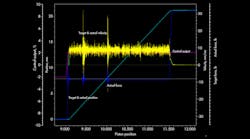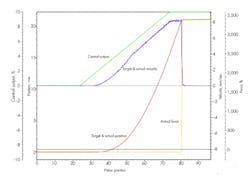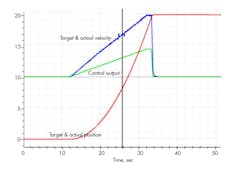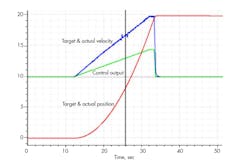Open-loop control is useful during commissioning or when trying to diagnose problems. The motion controller seems to get blamed for every little system problem, so if the motion controller can simply output a voltage, it is no different than if the voltage comes from a battery or power supply. This makes it possible to separate the controller’s control functions from an underlying problem with system operation.
One of the first things I like to do is set up some shortcut keys on the computer to generate a low positive voltage, a low negative voltage, and a zero voltage. A small control signal will safely move the piston the length of the cylinder without hitting the end too hard. I use this to make sure the valve is wired and plumbed correctly. I use the convention that a positive voltage makes the actuator extend, and a negative voltage makes the actuator retract. I also check that the feedback counts increase while the actuator extends. It is important to wire the position feedback correctly. If not, the actuator may slam into one end of the cylinder when the controller is put in closed-loop mode. This happens when the feedback is positive instead of negative. If the wiring cannot be changed, the polarity should be reversed in the controller’s software.
1. This illustration clearly shows the valve response deadband. As the (green) output voltage signal increases, the actual velocity does not move from zero until the control voltage reaches about 2 V. This may be fine if the application calls for running mostly on one edge of the spool but is not recommended for rapid position control.
Determining Scale and Offset
The next step is to determine the scale and offset to convert counts from the feedback device to user units like millimeters or inches. There are two ways to do this. The first requires moving the piston to two positions at either end of the stroke. The positions should be measured accurately, and the counts from the feedback devices should recorded at these two locations. The motion controller software should be able to calculate the scale factor and offset. If it can’t, then some simple high school algebra is required. Do you remember to how to calculate the equation for a line? If not, the motion controller software can calculate the scale factor and offset from the data given the two points.
The second method is easier, but it requires that the feedback device already has a scale factor. Magnetostrictive rods are now calibrated in microns per count, so you only need to convert microns to inches and find the offset. This requires moving the piston to a known position by moving it to a mechanical stop. Or you can measure the current position and counts and calculate the offset.
2. This plot from a linear-response valve clearly shows that as control voltage increases, the actual velocity increases immediately and linearly.
Setting Stroke Limits
Now the extend and retract limits can be set. The piston should be moved slowly using a low control signal against one end of the cylinder. The limits should be set just short of the cylinder end so that any erroneous command will be limited to prevent the piston from slamming against the end cap. A good hydraulic motion controller will detect an erroneous command and prevent the command from executing, if desired.
I like to move the axis back and forth a few times using the pre-programmed keys and look at the graph of the actual position and actual velocity. I usually start with a very small control signal just to check for a deadband on a valve. The cylinder will not move if the control voltage is not high enough to move the valve piston beyond the deadband (Fig. 1). If the valve has a linear response around the valve null position, I increase the voltage a little after each move and note how much faster the actuator moves (Fig. 2).
If the control signal is doubled from 10% to 20%, then the actuator speed should double, too. Figure 3 shows a valve with a dual-gain response, where the gain is one value near the zero-voltage position, but changes to a different gain when the control voltage reaches a certain value. This provides a good estimate of the open-loop gain. For instance, if the actual velocity changes from 50mm/sec to 100mm/sec when the control output changes from 10% to 20%, then the open-loop gain will be 50 mm/sec per 10%, or 5 mm/sec per 1%. Now it is easy to estimate the top speed at 100% control output to be 500mm/sec. In previous articles it was shown the velocity feed-forward value is the inverse of the open-loop gain, so the velocity feed forward in this example is 0.2% control/(mm/sec).
Other things I observe at when moving slowly back and forth in open loop is checking for smooth actual velocities. Sometimes there are rough spots in the cylinder or mechanical linkages that cause the velocity to change at certain positions. It is easy to see this on a graph of the actual position and velocity (Fig. 4).
3. This plot of a dual-gain valve response shows a clear change in the actual velocity at a 1.4-V control signal whereas the control voltage ramp remains linear.
Dealing with Stick-Slip Motion
The plots make it easy to identify rough spots or binding in the system during the cylinder stroke. Sometimes the system is trying to move a heavy load hampered by high static friction. Ideally, the friction should increase linearly with velocity. However, in the real world, static friction can be very high relative to dynamic friction. This results in what is referred to as stick-slip motion (or stiction), where two touching surfaces alternate between moving smoothly and stalling. This causes the motion to be jerky when moving slowly. Inside the cylinder, the pressure and force build up until the force is enough to overcome the static friction. The piston and load move, but the pressure and force fall rapidly as the oil expands. Eventually, the force is not enough to move the piston and load fast enough, so the piston and load stick again. This sticking and slipping happens fairly quickly. I have seen cases where the jerky motion has made the system unusable.
Most motion controllers cannot compensate for the rapid changes in load. More advanced motion controllers will try to reduce sudden changes in force. In some cases, the stick-slip may appear to be eliminated. Most likely, though, the effect of the stick-slip is reduced to where it isn’t noticeable. Stick-slip can be avoided if the static friction can be reduced. Stick-slip can also be reduced by using a larger-diameter cylinder, but that costs more money to build and more money to run.
As I get more confident in moving the actuator and load, I will move the actuator through faster and longer strokes. What I am looking for is the actual velocity staying constant when the control signal is constant. Failure to maintain a constant speed is often an indication that the system pressure is dropping from an accumulator being too small or not with a high-enough precharge to maintain a relatively constant system pressure.
Sometimes users have unrealistic expectations of what disturbances the hydraulic motion controller can correct for. Modern hydraulic motion controllers have 1 msec or even shorter loop times. The controller can respond to disturbances often within microseconds, moving electrons at near the speed of light. It is the valve response time and the time it takes flow to adjust the pressure and force in the cylinder that cause delays. A plot showing the actuator movement is helpful with determining the effects of the valve’s delayed response.
4. Cylinder rough spots can be seen just after 9.4 sec. at 3 in. and 10 sec at about 8.2 in.
Two Better Than One?
Finally, it is sometimes handy to have two open-loop modes: one for setup and diagnostics, the other for operation. The difference between the two modes is that the setup and diagnostic mode allows open-loop commands that ignore limits and faults. The operational open-loop modes will respond to such faults as moving beyond the set end limits or a feedback device failure.
Hydraulic motion control provides many opportunities for the use of open-loop control. Open-loop control, combined with plots or recording data, is extremely helpful in determining where to point the finger when problems arise. It is quite a handy tool to have when trying to diagnose performance problems.
Peter Nachtwey is president of Delta Computer Systems Inc., Battle Ground, Wash. For more information, visit www.deltamotion.com.






